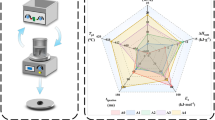Abstract
Aluminum (Al) nanoparticles have drawn much attention due to their high energy density and tunable ignition properties. In comparison with their micronscale counterpart, Al nanoparticles possess large specific surface area and low apparent activation energy of combustion, which reduce ignition delay significantly. In this paper, ignition and subsequently burning of consolidated Al nanoparticle pellets are performed via a continuous wave (CW) argon laser in a closed spherical chamber filled with oxygen. Pellets are fabricated using two types of nanoparticle sizes of 40–60 and 60–80 nm, respectively. A photodiode is used to measure the ignition delay, while a digital camera captures the location of the flame front. It is found that for the 40–60-nm nanoparticle pellets, ignition delay reduces with increasing the oxygen pressure or using the higher laser power. Analysis of the flame propagation rate suggests that oxygen diffusion is an important mechanism during burning of these porous nanoparticle pellets. The combustion characteristics of the Al pellets are compared to a simplified model of the diffusion-controlled oxidation mechanism. While experimental measurements of pellets of 40–60 nm Al particles agree with the computed diffusion-limiting mechanism, a shifted behavior is observed from the pellets of 60–80 nm Al particles, largely due to the inhomogeneity of their porous structures.











Similar content being viewed by others
References
Andisheh-Tadbir M, El Hannach M, Kjeang E, Bahrami M (2015) An analytical relationship for calculating the effective diffusivity of micro-porous layers. Int J Hydr Energy 40:10242–10250
Bazyn T, Krier H, Glumac N (2006) Combustion of nanoaluminium at elevated pressure and temperature behind reflected shock waves. Comb Flame 145:703–713
Bidabadi M, Fereidooni J (2013) Modelling ignition temperature and burning time of a single aluminium nanoparticle. Micro Nano Lett 8:783–787
Eisenreich N, Fietzek H, Juez-Lorenzo MD, Kolarik V, Koleczko A, Weiser V (2004) On the mechanism of low temperature oxidation for aluminium particles down to the nano-scale. Prop Expl Pyrotech 29:137–145
Glassman I (1996) Combustion, 3rd edn. Academic Press, San Diego
Granier JJ, Pantoya ML (2004) Laser ignition of nanocomposite thermites. Comb Flame 138:373–383
He W, Lv W, Dickerson JH (2014) Gas transport in solid oxide fuel cells. Springer Science, New York
Hunt EM, Pantoya ML (2005) Ignition dynamics and activation energies of metallic thermites: from nano- to micron-scale particulate composites. J Appl Phys 98:034909
Jian G, Chowdhury S, Sullivan K, Zachariah MR (2013) Nanothermite reactions: is gas phase oxygen generation from the oxygen carrier an essential prerequisite to ignition? Comb Flame 160:432–437
Jian G, Zhou L, Piekiel NW, Zachariah MR (2014) Low effective activation energies for oxygen release from metal oxides: evidence for mass-transfer limits at high heating rates. Chem Phys Chem 15:1666–1672
Li Y, Kalia R, Nakano A, Vashishta P (2013) Size effect on the oxidation of aluminium nanoparticle: multimillion-atom reactive molecular dynamics simulations. J Appl Phys 114:134312
Pantoya ML, Granier JJ (2005) Combustion behavior of highly energetic thermites: nano versus micro composites. Prop Expl Pyrotech 30:53–62
Park K, Lee D, Rai A, Mukherjee D, Zachariah MR (2005) Size-resolved kinetic measurements of aluminium nanoparticle oxidation with single particle mass spectrometry. J Phys Chem B 109:7290–7299
Rai A, Park K, Zhou L, Zachariah MR (2006) Understanding the mechanism of aluminium nanoparticle oxidation. Comb Theo Mod 10:843–859
Sandstrom MM, Oschwald D, Son SF (2004) Laser ignition of aluminium nanoparticles in air. 31st International Pyrotechnics Seminar
Stacy SC, Massad RA, Pantoya ML (2013) Pre-ignition laser ablation of nanocomposite energetic materials. J Appl Phys 113:213107
Stacy SC, Zhang X, Pantoya M, Weeks B (2014) The effects of density on thermal conductivity and absorption coefficient for consolidated aluminium nanoparticles. Int J Heat Mass Transf 73:595–599
Stamatis D, Dreizin EL (2011) Thermal initiation of consolidated nanocomposite thermites. Comb Flame 158:1631–1637
Sundaram DS, Yang V, Zarko VE (2015) Combustion of nano aluminium particles (review). Comb, Expl, Shock Waves 51:173–196
Wen JZ, Chaumeix N, Ory S, Matzen G (2015) Thermal stability and controlled oxidation of aluminium nanoparticles. Proceedings of Canadian Section of the Combustion Institute Spring Meeting MD1
Acknowledgments
The authors would like to acknowledge the financial support of Natural Sciences and Engineering Research Council of Canada (NSERC) through the Discovery grant.
Author information
Authors and Affiliations
Corresponding author
Rights and permissions
About this article
Cite this article
Saceleanu, F., Wen, J.Z., Idir, M. et al. Laser-assisted ignition and combustion characteristics of consolidated aluminum nanoparticles. J Nanopart Res 18, 328 (2016). https://doi.org/10.1007/s11051-016-3625-5
Received:
Accepted:
Published:
DOI: https://doi.org/10.1007/s11051-016-3625-5




